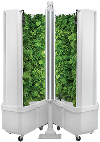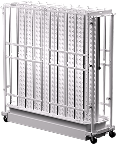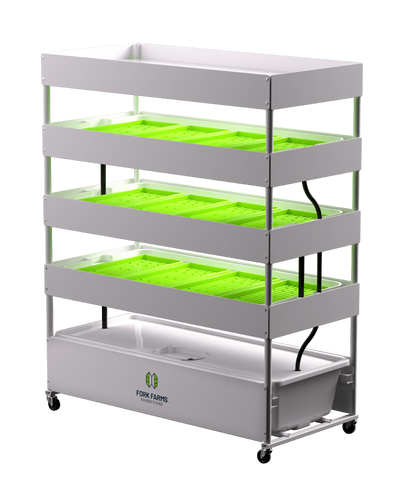Can You Grow Fruits And Vegetables In Any Season With Hydroponics?
The truth is, it can be challenging to grow produce indoors. There are a lot of elements needed for plants to thrive, such as sunlight, water, and nutrients, and the off-balance of just one or two can impact the entire crop. Regardless of whether you’re looking to grow produce in a classroom, greenhouse, or apartment, when it comes to indoor gardening, many things have to go right. That’s why many people are turning to hydroponics – a way of growing plants without the use of soil, under ideal controlled conditions.
Through the use of an indoor hydroponics system with tools such as nutrient-rich water, LED lights, and a hydro pump, people can grow fresh and nutritious produce year-round. Hydroponics is becoming so popular, in fact, people around the world are finding success with indoor gardening, making it possible to better bring food into communities that may have faced growing challenges for a variety of reasons.
Growing Fresh Produce with Hydroponics
Hydroponics makes it possible for anyone, from aspiring growers to experienced gardeners, to make the most out of their indoor gardening efforts. In addition to helping growers have more control over the outcome, hydroponics also enables gardeners to grow a larger harvest more sustainably. Hydroponic systems use less land, water, and energy, making them an attractive alternative to traditional indoor gardening methods.
Hydroponic growing also comes in handy for communities working with limited resources or short growth seasons. A report conducted by Arizona State concluded that hydroponics used about one-tenth of the water compared to traditional farming, a crucial amount in such a dry region. Hydroponics helps communities in Alaska to grow year-round, even through the coldest and snowiest months. Hydroponic gardening is popular in muggy and wet Florida, and greenhouses throughout New York City are helping to supply the area with more local produce.
With so many benefits coming from hydroponic indoor gardening, the opportunities are truly endless.
Is it Possible to Grow Food All Year With An Indoor Hydroponic Garden?
Yes! With indoor hydroponics, people can grow produce quickly without worrying too much about disease, pests, weather, or other common outdoor growth challenges. Depending on the indoor hydroponics system used, gardeners can even grow 25+ lbs of fresh food every 28 days!
That’s enough to provide necessary produce to a community, college, school, farmer’s market, or restaurant in a variety of seasons and climates.
In 2021, for example, Raleigh, North Carolina obtained their own community hydroponics garden. The University of Wisconsin-Eau Claire has two hydroponic gardens to help provide students with fresh produce, and after receiving unsatisfactory produce for school lunches, Morgan Hill Unified School District in California invested in its own hydroponic garden. Providence Public Library invested in a hydroponic garden as a part of its community gardening initiatives. Even the Institute of Culinary Education (ICE) in New York City has its own indoor hydroponic garden. These spaces allow urban, suburban, and rural regions all over the United States to provide fresh produce year-round while also offering vital education opportunities about growing plants indoors.
Determining Which Vegetables, Fruit, and Herbs to Grow with Hydroponics
Everyone from restaurateurs to educators can benefit from investing in an indoor hydroponic system. There are a lot of plants that can be grown through the use of a hydroponics system, and according to various sources, plants that can be grown indoors include:
Vegetables
Vegetables from bok choy to celery to chard can be grown indoors with hydroponics. The blogger, Our Little Suburban Farmhouse, who uses hydroponics as their growth method, has experimented with a range of veggies that includes beetroot, radish, eggplant, cucumber, green onion, peas, and mustard greens. In Hydroponics: A Practical Guide for the Soilless Grower, by J. Benton Jones Jr., additional vegetables suggested also include okra, chile peppers, and bell peppers. Seeds Now, a website that sells seeds, also lists broccoli and broccoli rabe, brussels sprouts, cabbage, and cauliflower as options for hydroponic growing.
The menu of Balance Pan-Asian Grille, a restaurant with a hydroponic garden in Toledo, has a handful of these vegetables in its dishes. Customers can enjoy rice bowls, tacos, and healthy “bites,” such as citrus brussel sprouts with veggies grown right on site.
Herbs
Fresh herbs are one of the best and easiest greens to grow in a hydroponic system. The Spruce, an online website dedicated to home decor, cleaning, home improvement, and gardening, recommends herbs such as dill, basil, mint, parsley, and cilantro. In Hydroponics: A Practical Guide for the Soilless Grower, additional herbs may include chives, marjoram, oregano, rosemary, sage, and thyme. Seeds Now also recommends lemon balm and tarragon.
Marriott International’s Element Hotel chains invested in hydroponic gardens that provide herbs, amongst veggies, to their guests and chefs. Their continental breakfast, for example, is prepared using herbs and garnishes grown right at the hotel.
Fruit
Fruit is a great item to grow to save money, as fruit can be costly at the grocery store. The nature website Trees.com shares that fruit including blueberries and strawberries can be grown hydroponically, while Hydroponics: A Practical Guide for the Soilless Grower also recommends watermelon and cantaloupe. In the Caribbean, farmers are using hydroponic gardens to support the food system, growing produce such as strawberries.
Flowers
While many flowers aren’t edible, some can be used for tea and medicinal purposes. It’s important to do research in terms of what can be ingested and in what amounts, however, for growing through hydroponics, Seeds Now recommends chamomile, chicory, dandelion, lavender, marigold, soapwort, and tansy. Farm.One NYC, an urban hydroponic farm, grows edible flowers as well as herbs and greens for local chefs and bartenders.
Choosing Your Indoor Hydroponic Garden
No matter what your goals for hydroponic gardening are, there’s a range of hydroponic gardens to choose from, each with its own advantages. A vertical system such as our Flex Farm, for instance, is a great option for indoor spaces, no matter how much produce you’re working to yield. Fork Farms also supports customers during sales, onboarding, setup, and the growth process, making it easy to get started. Then, while using one of our innovative hydroponic farms, customers can join our active community of growers and farmers to get advice, share tips, and troubleshoot.
Ready to get more information about the possibilities of hydroponic gardening? Explore the capabilities of our Flex Farm today!
Important Links:
























